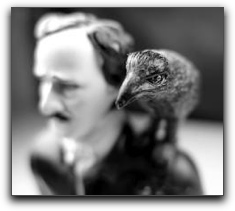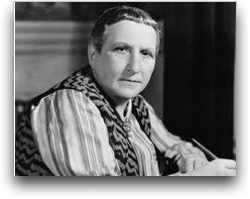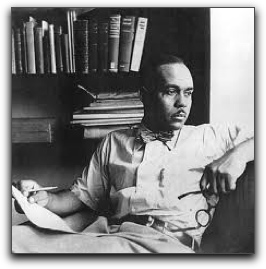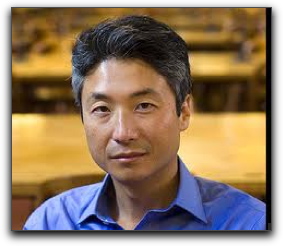Department of English
ENG 170: “Introduction to Literary Study: A Move Toward the Other,” (Spring 2011 and  2012). This course familiarizes students with the professional critical approaches involved in the study of literature such as psychoanalysis, new historicism, critical race theory, feminist theory, and cultural studies. Among the writers featured in the course are William Shakespeare, Mary Shelley, Herman Melville, Jessica Hagedorn, David Henry Hwang, and Ralph Ellison.
2012). This course familiarizes students with the professional critical approaches involved in the study of literature such as psychoanalysis, new historicism, critical race theory, feminist theory, and cultural studies. Among the writers featured in the course are William Shakespeare, Mary Shelley, Herman Melville, Jessica Hagedorn, David Henry Hwang, and Ralph Ellison.
ENG 221: “English & American Literature: Origins to Early 20th Century,” (Spring 2007). This is a team-taught (four professors total) canonical survey of  the Anglo tradition of English letters. I have lectured on American writers such as Equiano, Poe, Melville, Emerson, Thoreau, Douglass, Jacobs, Chestnutt and Dubois.
the Anglo tradition of English letters. I have lectured on American writers such as Equiano, Poe, Melville, Emerson, Thoreau, Douglass, Jacobs, Chestnutt and Dubois.
ENG 226: “American Literature, 1865-1925: Inquiries into Identification and Knowledge,” (Fall 2006, Spring 2011, Spring 2012). The objective of this course is to make students more familiar with post Civil War American literature. The writers of the time were being called to reckon with the increasing industrialization and commodification of American society. Thus we explore the realist, naturalist, and modernist literary production that characterize this period, with a particular eye on how artists cast the epistemological crisis that beset their  society. How do these texts comment on how we know what we know? What are the ways and means by which truth is authenticated or disputed? Do Americans still have access to the real or is the real lost for good? Course featured the works of Whitman, Howells, James, Crane, Eliot, Wharton, Gilman, Twain, Toomer, Hughes, Yezierska, Gold, Faulkner, and Dubois.
society. How do these texts comment on how we know what we know? What are the ways and means by which truth is authenticated or disputed? Do Americans still have access to the real or is the real lost for good? Course featured the works of Whitman, Howells, James, Crane, Eliot, Wharton, Gilman, Twain, Toomer, Hughes, Yezierska, Gold, Faulkner, and Dubois.
ENG 322: “To Make a Fiction of My Life?”: The Art and Voice of John Edgar Wideman,” (Spring 2006). This is an advanced literature seminar on Wideman’s works ( genres included novels, autobiography, collections of cultural and literary criticism, political essays, and travel narratives) that considers his ouevre beside some of the most distinguished theorists of black literary expression. We assess the ways in which Wideman’s work abides by a racialized tradition as well as consider the extent to which his writing self-consciously seeks to preserve and perpetuate such a tradition. The experience was geared to make to students more familiar with the tropes and techniques of black postmodern writing. The course featured the works of Ralph Ellison, Houston Baker, Edward Said, Henry Giroux, Paul Gilroy, and Julia Watson.
(Spring 2006). This is an advanced literature seminar on Wideman’s works ( genres included novels, autobiography, collections of cultural and literary criticism, political essays, and travel narratives) that considers his ouevre beside some of the most distinguished theorists of black literary expression. We assess the ways in which Wideman’s work abides by a racialized tradition as well as consider the extent to which his writing self-consciously seeks to preserve and perpetuate such a tradition. The experience was geared to make to students more familiar with the tropes and techniques of black postmodern writing. The course featured the works of Ralph Ellison, Houston Baker, Edward Said, Henry Giroux, Paul Gilroy, and Julia Watson.
ENGL 325: “Fictions of Black Urbanism in the Post-War United States: Bodies and Belonging; Borders and Mobility,” (Spring 2005, Spring 2007, Fall 2009, Fall 2011, and Fall 2012). This advanced literary seminar explores how African American writers stage the black encounter with the American city. The course featured the fiction of Gwendolyn Brooks, James Baldwin, Ann Petry, Chester Himes, Charles Johnson, Toni Morrison, Gloria Naylor, John Edgar Wideman, Sapphire, and Colson Whitehead.
ENGL 381: “Critical Race Theory in Literature And Culture: Unthinking Race in the Age of its Recrudescence,” (Spring 2005, Spring 2009, and Fall 2010). Advanced literary seminar  that reviews the interdisciplinary scholarship in race studies and attempts to apply these insights to popular texts (i.e. Grand Theft Auto) and contemporary American novels. Theorists included Immanuel Kant, Robyn Wiegman, Richard Slotkin, Frantz Fanon. William Faulkner, Chang Rae Lee, Danzy Senna, Junot Diaz, Gloria Alvarez, Jean Toomer, Michael Gold, Anzia Yezierska, and Philip Roth were among the literary artists featured.
that reviews the interdisciplinary scholarship in race studies and attempts to apply these insights to popular texts (i.e. Grand Theft Auto) and contemporary American novels. Theorists included Immanuel Kant, Robyn Wiegman, Richard Slotkin, Frantz Fanon. William Faulkner, Chang Rae Lee, Danzy Senna, Junot Diaz, Gloria Alvarez, Jean Toomer, Michael Gold, Anzia Yezierska, and Philip Roth were among the literary artists featured.
Program in American Studies
AMCL 181/ ENGL 101: “The Criminal and The Carceral,” (Spring 2005, Fall 2005, Fall 2006, Spring 2009, and Fall 2009). This course provided an introductory writing seminar for up to 18 first year students per semester. The course explored the burgeoning prison industrial complex and the cultural practices that are transforming the United States into a police society. Among the featured writers in this course were Ruth Gilmore, Hubert Selby Jr., Chester Himes, John Edgar Wideman, Michel Foucault, Christian Parenti, Angela Davis, and David Lyon.
AMCL 250: “America and The World,” (Fall 2010 and Spring 2013). The purpose of this course for the 20 students that took it was to explore the multifaceted way that America has always surged beyond its normative national boundaries to define itself and to affect the rest of the world. We also considered the way the rest of the world has responded to America’s varied political, cultural, religious, economic, and military expansionist techniques. Finally, in the grand tradition of American Studies, we considered these dynamics in a multidisciplinary fashion, using a diverse set of methods and texts. Among the writers featured in the course were W.E. B. Dubois, Alexis De Tocqueville, Jill Lepore, Theodore Roosevelt, Richard Slotkin, Brent Edwards and Eva Cherniavsky.
AMCL 282: “The United States-Mexico Border: Nation, God, and Human Rights in Arizona-Sonora,” (Spring 2009 and Spring 2012). This team-taught course (three professors total) asks students to reflect upon the past and present history of the border between the US and Mexico. In doing so, we lecture on nationalism, racial identity, spatial theory, and liberation theology, Among the materials we used were writings by Ken Ellingwood, Gioacchino Campese, Giorgio Agamben, Matthew Sparke, Linda Gordon, Jeffrey Stout, and Leslie Marmon Silko. The course featured an elaborate experiential component in which students visit the Arizona-Sonora region for two weeks, where they meet with actors (activists, law enforcement officials, clergy) in the border conflict.
AMCL 313: “Multidisciplinary Research Methods: The Practice of Cultural Studies,” (Fall 2009 and Spring 2013). This course pursued the dual objectives of having seniors write the early chapters of their theses while simultaneously familiarizing themselves with the methods and practices of American Studies scholarship. Among the materials included in this effort were Samuel Delany, Janice Radway, Imani Perry, Jonathon Kahn, and Casey Nelson Blake.
Urban Studies Program
URBS 100: “Introduction to Urban Studies,” (Fall, 2009). I serve the course as a visiting lecturer on American Literature and Urban Theory.
URBS 200: “Urban Theory,” (Spring 2010 and Fall 2011). This course reviews the development of theories regarding the modern city, the production of space, and the meaning of urban experience. Namely, the course explored the tradition of anti-urbanism in the West as it was inspired by Victorian sociologists that construct the urban as a problem to be solved. It highlighted the ongoing tension between planners and users and thus seeks to understand the city as a site of contestation and struggle. It also examines how the globalization of capital morphs the city and its cultures. Students are required to venture out into Poughkeepsie and measure the extent to which these concerns of anti-urbanism, struggle and globalization are in play. Robert Park, Rem Koolhaus, Sudhir Venkatesh, David Wilson, Jane Jacobs, and Marshall Berman were among the authors featured in this course.
URBS 289/269: “Shades of the Urban: Views on Urban Space,” (Spring 2006 and Fall 2006). This reading seminar asks students to move between the real and the unreal. If we heed the contention of many postmodern urbanists that there is no city without the vast archive of individual descriptions that bring it into being (that is, we make the city what it is when we describe it), then we must accept that literature about the metropolis provides us with a sublimated window by which to view the truth about cities. I ask students to use urban theory and urban novels to ferret out the truth of urban experience in the century that has just expired. Theorists included Henri Lefebvre, Michel De Certeau, Joan Resina, Dell Upton and featured the fiction of Theodore Dreiser, Chang-Rae Lee, Gwendolyn Brooks, and Ernesto Quinonez
– URBS 286: “The American City: Life in The Urban Maze,” (SPRING 2005 and FALL 2005). This course offers a readings seminar on urban theory and culture that often used the major metropolises of Los Angeles, New York, and Chicago as their primary sites of interrogation. Featured writers included David Harvey, Edward Soja, Rosalyn Deustche, Samuel Delany, Robert Orsi, and Susan Buck-Morss.
URBS/ENST 288: “Rethinking New Orleans’s Future,” Instructor Pinar Batur: (Spring 2006). I was two-week guest lecturer on the issues of Critical Race Theory and Urban Restructuring in an interdisciplinary lecture class looking at the social and environmental crises that emerged in New Orleans, Louisiana in the wake of Hurricane Katrina.
Africana Studies Program
ENG 251/AFRS 251: “Narrative, Black Existence, and the Self beyond the Problem” (Fall 2012). “How does it feel to be a Problem?” With this question, W.E.B. DuBois opened The Souls of Black Folk, his lengthy meditation on the condition of African Americans in the modern era. No doubt DuBois saw the white Victorian readers who would constitute the bulk of his audience as problematic. To that moment in history, these readers had forestalled black admission to modernity by means of plantation slavery and other forms of underpaid peonage. But his question was not so much directed at this audience as it was an attempt to ventriloquize its sentiments towards blacks. It was blacks who functioned as modernity’s existential riddle and modernity’s deliverance would depend on how Western societies would creatively answer this query. Yet in this question there was also a challenge issued to the black readers of his book. Dubois’s query pointed to an existential crisis in which most blacks were mired. After years of epochal discomfort, it appeared that blacks hardly knewwho they were outside of modernity’s gaze. What did blacks see when they looked at themselves? Were they impressed? sanguine? troubled? terrified? This course takes as its organizing premise that much of black writing has engaged Dubois’s question about black existence-not only what it means to live life as an object for others, but also what it means to live life as a subject for one’s self–with a great deal of urgency. As a consequence, it will feature narratives that seek to respond to this complex query with its due complexity. Authors include Equiano, Kelley, Hurston, Baldwin, and Shange.
AFRS 229: “Black Intellectual History,” (Spring 2010 and Spring 2011). This course leads students through a survey of Black thought beginning with the late 18th century until the present. We focus on the ways that Black people in the New World understood themselves and the world around them in a society that tried to deny them their full humanity. We are particularly attentive to the diversity of individual opinions about progressive racial action and the challenges many faced as they tried to unite theory and practice. At the same time, we are particularly attentive to the recurring themes in each historical moment. Among the materials featured, were writings from Marcus Rediker, Anthony Bogues, Cornel West, Toni Morrison, Frantz Fanon, Manning Marable, and Paula Giddings.
